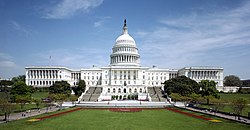
| Home | Sources Directory | News Releases | Calendar | Articles | | Contact | |
1983 United States Senate bombing
Coordinates: 38–53'42'N 77–02'10'W�»¿ / �»¿38.895–N 77.036–W
| 1983 United States Senate bombing | |
|---|---|
 |
|
| Location | Washington, D.C. |
| Date | November 7, 1983 10:58 pm (UTC-5) |
| Target | United States Senate |
| Attack type | bombing |
| Death(s) | 0 |
| Injured | 0 |
| Belligerent(s) | Resistance Conspiracy |
The 1983 U.S. Senate bombing was a bomb explosion at the United States Senate on November 7, 1983. Six members of the "Resistance Conspiracy" were arrested in May 1988 and charged with the bombing, as well as related bombings of Fort McNair and the Washington Navy Yard.
On that day, the Senate adjourned at 7:02 p.m. A crowded reception, held near the Senate Chamber, broke up two hours later. At 10:58 p.m. an explosion tore through the second floor of the Capitol's north wing; the adjacent halls were virtually deserted.[1]
Minutes before the blast, a caller claiming to represent the "Armed Resistance Unit" had warned the Capitol switchboard that a bomb had been placed near the Chamber in retaliation for recent U.S. military involvement in Grenada and Lebanon.[1]
The force of the device, hidden under a bench at the eastern end of the corridor outside the Chamber, blew off the door to the office of Democratic Leader Robert C. Byrd. The blast also punched a hole in a wall partition sending a shower of pulverized brick, plaster, and glass into the Republican cloakroom. Although the explosion caused no structural damage to the Capitol, it shattered mirrors, chandeliers, and furniture. Officials calculated damages of $250,000.[1]
A portrait of Daniel Webster, located across from the concealed bomb, received the explosion's full force. The blast tore away Webster's face and left it scattered across the Minton tiles in one-inch canvas shards. Senate curator James Ketchum rescued the fragments from debris-filled trash bins. Over the coming months, a conservator painstakingly restored the painting to a credible, if somewhat diminished, version of the original.[1]
Following a five-year investigation, federal agents arrested six members of the Resistance Conspiracy on May 12, 1988 and charged them with bombings of the Capitol, Fort McNair, and the Washington Navy Yard.[2] On December 7, 1990, federal judge Harold H. Greene sentenced Laura Whitehorn and Linda Evans to lengthy prison terms for conspiracy and malicious destruction of government property. The court dropped charges against three co-defendants, already serving extended prison sentences for related crimes. Whitehorn was sentenced to 20 years; Evans to 5 years concurrent with 35 years for illegally buying guns.[3]
The 1983 bombing marked the beginning of tightened security measures throughout the Capitol. The area outside the Senate Chamber, previously open to the public, was permanently closed. Congressional officials instituted a system of staff identification cards and added metal detectors to building entrances to supplement those placed at Chamber gallery.[citation needed]
[edit] References
- ^ a b c d "November 7, 1983: Bomb Explodes in Capitol". United States Senate. http://www.senate.gov/artandhistory/history/minute/bomb_explodes_in_capitol.htm. Retrieved February 14, 2010.
- ^ Shenon, Philip (May 12, 1988). "U.S. Charges 7 In the Bombing At U.S. Capitol". The New York Times. http://www.nytimes.com/1988/05/12/us/us-charges-7-in-the-bombing-at-us-capitol.html. Retrieved February 14, 2010.
- ^ "Radical Gets 20-Year Term in 1983 Bombing of U.S. Capitol". Associated Press. December 8, 1990. http://www.nytimes.com/1990/12/08/world/radical-gets-20-year-term-in-1983-bombing-of-us-capitol.html. Retrieved February 14, 2010.
|
SOURCES.COM is an online portal and directory for journalists, news media, researchers and anyone seeking experts, spokespersons, and reliable information resources. Use SOURCES.COM to find experts, media contacts, news releases, background information, scientists, officials, speakers, newsmakers, spokespeople, talk show guests, story ideas, research studies, databases, universities, associations and NGOs, businesses, government spokespeople. Indexing and search applications by Ulli Diemer and Chris DeFreitas.
For information about being included in SOURCES as a expert or spokesperson see the FAQ or use the online membership form. Check here for information about becoming an affiliate. For partnerships, content and applications, and domain name opportunities contact us.